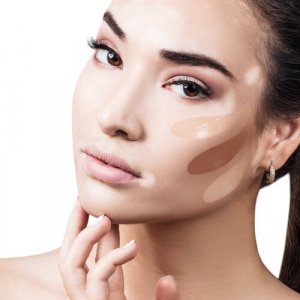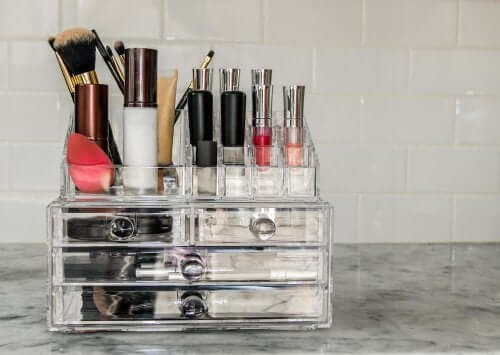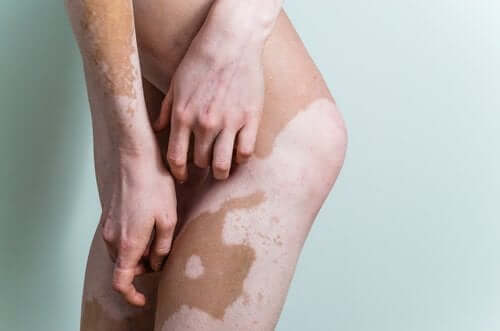Corrective Makeup in Dermatology

Corrective makeup in dermatology is specially made to conceal imperfections. In addition, it helps make your skin look better after certain skin conditions. This type of makeup is useful to:
- Alleviate the consequences of burns
- Improve cosmetic dermatology or plastic surgery
- Minimize the side effects of cancer treatments
Corrective makeup also has great psychological benefits. It helps your skin look good and improves your image. Therefore, for people with certain skin conditions, it can boost their self-esteem and quality of life.
Features of corrective makeup
Corrective makeup has a few important characteristics. For example, some of them are:
- Good coverage
- Natural results: quick and easy application
- Safe for skin: hypoallergenic with clinical results
- Stays on your skin for a while
- Water and sweat-resistant
- Fragrance-free
- Adaptable for use on your face and body
- Removes easily
Basics of concealer
On the color wheel, each color has an opposite color. The principle of opposite colors is that the opposites cancel each other out. Therefore, green neutralizes red, and yellow neutralizes purple.
This principle lets you camouflage red or purple marks with the opposite colored concealer. This way, you don’t need to use as much skin-tone concealer.

Also read: 5 Makeup Tricks for Covering Eye Bags
Indications in dermatology
There are lots of reasons to use corrective makeup. In fact, some of the most common ones are:
- To cover small imperfections: dark circles, spots or blemishes.
- Dermatosis: acne or rosacea.
- Hyper or hypopigmentations: lentigines, melasma or vitiligo.
- Vascular disorders: couperosis or angiomas.
- After cosmetic dermatology or plastic surgery: chemical peels, lasers or botox.
- Camouflage: from burns and scars.
When using corrective makeup in cancer patients, in addition to applying makeup, sometimes you need to draw in the eyebrows. To do this, you need to make small strokes like natural eyebrows. However, if there’s partial or total alopecia, take 3 reference points to redraw the eyebrows.
If the eyelashes have decreased or disappeared due to cancer treatments, apply an eyeliner to the base of the upper lashes. This way, you’ll be able to define and recreate the appearance of eyelashes.

Corrective makeup in cancer patients
Corrective makeup, in dermatology, is especially important for patients going through cancer treatment. In fact, skin side effects are common in chemotherapy and other targeted therapies.
It’s important for people to feel good about their appearance because it boosts their self-esteem and self-confidence. Therefore, makeup helps them face treatments with a more positive attitude. Also, they can improve their personal and social relationships.
In addition, corrective makeup helps mitigate the most frequent changes in facial skin with cancer treatments. These changes include dryness, fatigue, blemishes and hyperpigmentation. Also, it can include redness and hair loss in eyebrows and lashes.
Before using makeup, wash your face gently. To do this, use a cleanser or hydrating face wash.
Hydrating your face is extremely important because dry skin is one of the most common side effects of chemotherapy. Here, it’s important to use hypoallergenic products.
Also, we recommend using a moisturizing mask 1 or 2 times a week. Of course, make sure to always use sunscreen. In fact, cancer treatments make you more sensitive to the sun. Therefore, you should also limit your time in the sun as much as possible.
You might also like: Rocío Gil Redondo’s Tips for Skin Care and Rejuvenation
Conclusion
If you suffer from certain skin conditions or are going through cancer treatment, corrective makeup is a tool that can benefit you both physically and emotionally. In addition to making you look good, these products can also help medically.
https://mejorconsalud.com/indicaciones-maquillaje-corrector-dermatologia/
All cited sources were thoroughly reviewed by our team to ensure their quality, reliability, currency, and validity. The bibliography of this article was considered reliable and of academic or scientific accuracy.
-
Riva Grandal, Á., Santiago Sánchez Mateos, J., & Rodríguez Martín, C. (2009). Maquillaje terapéutico sobre lesiones dermatológicas faciales: revisión bibliográfica. Enfermería Dermatológica.
-
Padilla-España, L., & de Troya-Martín, M. (2013). El maquillaje corrector en la dermatología pediátrica: cuándo y cómo. Piel. https://doi.org/10.1016/j.piel.2013.03.017
-
Alcalde Lorca, I. (2008). Maquillaje dermatológico corrector. Enferm Dermatol.
This text is provided for informational purposes only and does not replace consultation with a professional. If in doubt, consult your specialist.








